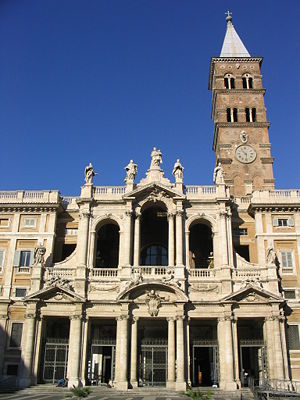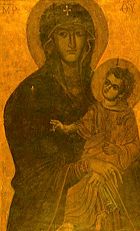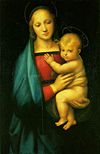Basilica di Santa Maria Maggiore

The Basilica di Santa Maria Maggiore (its Italian name), known in English also as St Mary Major,[1] is an ancient Catholic basilica of Rome. It is one of the four major or four papal basilicas,[2] which, together with St. Lawrence outside the Walls, were formerly referred to as the five "patriarchal basilicas" of Rome, associated with the five ancient patriarchal sees of Christendom (see Pentarchy). The other three papal or major basilicas are St. John Lateran, St. Peter and St. Paul outside the Walls. The Liberian Basilica (another title for the church) is one of the tituli, presided over by a patron—in this case Pope Liberius—that housed the major congregations of early Christians in Rome. Santa Maria Maggiore is the only Roman basilica that retained the core of its original structure, left intact despite several additional construction projects and damage from the earthquake of 1348.
The name of the church reflects two ideas of greatness ("major"), that of a major (or papal) basilica and that of the largest (major) church in Rome dedicated to the Blessed Virgin Mary.
After the Avignon papacy formally ended and the Papacy returned to Rome, the Basilica became a temporary Palace of the Popes due to the deteriorated state of the Lateran Palace. The papal residence was later moved to the Palace of the Vatican in what is now Vatican City.
Contents |
Papal basilica
A papal basilica, Santa Maria Maggiore is often personally used by the pope. Most notably, the pope presides over the annual Feast of the Assumption of Mary, celebrated each August 15 at the basilica. A high, canopied altar dedicated to the pope is used by the pope alone — except for a choice few priests including the archpriest. The pope gives charge of Basilica di Santa Maria Maggiore to an archpriest, usually an archbishop made cardinal in consistory. The archpriest was formerly the titular Latin Patriarch of Antioch, a title abolished in 1964.
|
General articles |
|
Expressions of devotion |
|
Specific articles |
The current archpriest of the Basilica di Santa Maria Maggiore is Cardinal Bernard Francis Law; John Paul II assigned Law to this position after his resignation as Archbishop of Boston on December 13, 2002, in an act that elicited much criticism, given the fact that Law was arguably one of the most controversial Church officials in the United States. It was in his archdiocese that the 2002 scandal initially erupted.
In addition to the archpriest and his servant priests, a chapter of canons are resident in Basilica di Santa Maria Maggiore. In addition, Redemptorist and Dominican priests serve the church daily — hearing confessions and administering other sacraments.
Origin
Pope Liberius commissioned the construction of the Liberian Basilica, circa 360. According to the founding legend, which cannot be traced farther back than the thirteenth century,[3] he wanted a shrine built at the site where an apparition of the Blessed Virgin Mary manifested herself in identical dreams shared by a local patrician and his wife and by the pope. According to tradition, the outline of the church was physically laid out on the ground of the noble's property by Liberius himself under a miraculous but predicted snowfall that took place on the night August 4-5 352.[4] The legendary Miracle of the Snow was depicted by Masaccio and Masolino about 1423 in a triptych commissioned by a member of the Colonna family for the Basilica, now conserved in the Museo di Capodimonte, Naples.[5] In it the miracle is witnessed by a crowd of holy men and women and observed from above by Jesus and the Virgin Mary. Dedicated to the Blessed Virgin Mary under the title of Our Lady of the Snows, local Roman Catholics commemorate the miracle on each anniversary by dropping white rose petals from the dome during the feast mass.
Salus Populi Romani

The column in the Piazza celebrates the famous icon of the Virgin Mary in the Borghese or Pauline Chapel of the Basilica. It is known as Salus Populi Romani, or Health of the Roman People, due to a miracle in which the icon helped keep plague from the city. The icon is at least a thousand years old, and tradition holds that it was painted from life by St Luke the Evangelist. (According to published material at the Basilica, radiocarbon dating establishes the age of the icon to be approximately 2,000 years, thus reinforcing its sacred tradition.)
The Salus Populi Romani has been a favorite of several Popes and acted as a key Mariological symbol. Roman born Pope Pius XII (Eugenio Pacelli) celebrated his first Holy Mass there on April 1, 1899. In 1953, the icon was carried through Rome to initiate the first Marian year in Church history. In 1954, the icon was crowned by Pope Pius XII as he introduced a new Marian feast Queenship of Mary. Pope Paul VI, Pope John Paul II and Pope Benedict XVI all honoroured the Salus Populi Romani with personal visits and liturgical celebrations.
Architecture

The precise location of that first church has been lost. The present building dates from the time of Pope Sixtus III (432 - 440) and contains many ancient mosaics from this period. Its form so exactly follows the conventions of an imperial basilica it has at times been taken for one.[6]The Athenian marble columns supporting the nave are even older, and either come from the first basilica, or from another antique Roman building; thirty-six are marble and four granite, pared down, or shortened to make them identical by Ferdinando Fuga, who provided them with identical gilt-bronze capitals.[7] The campanile, tallest in Rome, was constructed in the fourteenth century. The basilica's 16th-century coffered ceiling, to a design by Giuliano da Sangallo, is said to be gilded with Inca gold presented by Ferdinand and Isabella to the Spanish pope Alexander VI (something which factually is erroneous, since the Inca empire was conquered during the reign of Charles V). The medieval bell tower is the highest in Rome, at 240 feet, (about 75 m.). The apse mosaic, the Coronation of the Virgin, is from 1295, signed by the Franciscan friar, Jacopo Torriti. The Basilica also contains frescoes by Giovanni Baglione, in the Cappella Borghese.
The 12th-century façade has been masked by a reconstruction, with a screening loggia, that were added by Pope Benedict XIV in 1743, to designs by Ferdinando Fuga that did not damage the mosaics of the façade. The wing of the canonica (sacristy to its left and a matching wing to the right (designed by Flaminio Ponzio) give the basilica's front the aspect of a palace facing Piazza Santa Maria Maggiore. To the right of the Basilica's façade is a memorial representing a column in the form of an up-ended cannon barrel topped with a cross: it was erected by Pope Clement VIII immediately after the St. Bartholomew's Day massacre of Protestants, though today it is reputed to celebrate the end of the French Wars of Religion [1].
The Marian column erected in 1614, to designs of Carlo Maderno is the model for numerous Marian columns erected in Catholic countries in thanksgiving for remission of the plague during the Baroque era. (An example is the Holy Trinity Column in Olomouc, the Czech Republic). The column itself is the sole remaining from Constantine's Basilica of Maxentius and Constantine in Campo Vaccino, as the Roman Forum was called until the 18th century[2]; Maderno's fountain at the base combines the armorial eagles and dragons of Paul V.
Restoration
In the centuries that have passed, the weather has been Santa Maria Maggiore's biggest rival. The pollution of a modern city combined with humidity puts at risk the old churches and the artwork they hold. Centuries before the first vehicle spewed exhaust into the city, during the late sixteenth century, a number of the Vatican's churches were renovated and redecorated. The basilica itself was restored and extended by various popes, including Eugene III (1145-1153), Nicholas IV (1288-92), Clement X (1670-76), and Benedict XIV (1740-58), who in the 1740s commissioned Ferdinando Fuga to build the present façade and to modify the interior. The interior of the Santa Maria Maggiore underwent a broad renovation encompassing all of its altars between the years 1575 and 1630.

List of major works of art in the basilica
- Early Christian mosaic cycle depicting Old Testament events, 5th century
- The Salus Populi Romani, a much venerated early icon of the Virgin and Child.
- Funerary monument of Clement IX (1671) by Carlo Rainaldi with the papal bust is by Domenico Guidi.
- Temporary catafalque for Philip IV of Spain designed in 1665 by Rainaldi
- Funerary monument of Pope Nicholas IV, designed by Domenico Fontana in 1574.
- Bust of Costanzo Patrizi by Algardi.
- Sacristy frescoes by Passignano and Giuseppe Puglia,
- Saint Cajetan holding the Holy Child, by Bernini.
- High altar sculpture by Pietro Bracci, (c. 1750).
- Bust of Pius IX (1880) by Ignazio Jacometti.
- Pauline Chapel frescoes, by Guido Reni
- Frescoes for the monument of Clement VIII, Lanfranco
- Cesi Chapel tombs by Guglielmo della Porta
- Altar, confessio and Presepio (crib) sculptures by Arnolfo di Cambio, about 1290
The Capella Sistina and the Crypt of the Nativity
Below the sanctuary of Basilica di Santa Maria Maggiore is the Crypt of the Nativity or the Bethlehem Crypt, which is the burial place for prominent Catholics, including Saint Jerome, the 4th century Doctor of the Church who translated the Bible into the Latin language (the Vulgate); popes; and Gianlorenzo Bernini. Saint Ignatius of Loyola presided over his first mass as a priest on this altar on December 25, 1538 (previously below the central main altar).
The decoration of the Sistine chapel of Santa Maria Maggiore, which should not be confused with the more famous Sistine chapel of the Vatican, was commissioned by the administration of Pope Sixtus V. The architect Domenico Fontana was called to design the chapel to house the presumptive relics of the Nativity crib. The original Nativity Oratory, with the presepe built in the XIII century by Arnolfo di Cambio, is below the chapel. The chapel contains the tombs of Sixtus V and his early patron Pius V (design by Fontana and statue by Leonardo Sarzana). The statue of Sixtus V was sculpted by Giovanni Antonio Paracca, called il Valsoldo. The main altar in the Chapel has four gilded bronze angels by Sebastiano Torregiani, along the ciborium.
The Mannerist interior decoration was completed (1587-9) by a large team of artists, directed by Cesare Nebbia and Giovanni Guerra. While the art biographer, Giovanni Baglione allocates specific works to individual artists, recent scholarship finds that the hand of Nebbia drew preliminary sketches for many, if not all, of the frescoes. Baglione also concedes the roles of Nebbia and Guerra could be summarized as "Nebbia drew, and Guerra supervised the teams".
| Painter | Work |
|---|---|
| Giovanni Battista Pozzo | Angelic Glory, Visitation, Annunciation, Joseph’s dream, St. Paul & John Evangelist, St. Peter enters Rome,& Massacre of infants |
| Lattanzio Mainardi | Tamar, Fares, Zara, Solomon, & Boaz |
| Hendrick van den Broeck (Arrigo Fiammingo) | Esrom, Aram, Aminabad & Naassom |
| Paris Nogari | Ruth, Jesse, David, Solomon & Roboam; & the Holy Family |
| Giacomo Stella | Jehoshaphat & Jehoram, Jacob, Judah & his brothers, Sacrifice of Isacc |
| Angiolo Nebbia | Ozias & Jonathan, Abiud and Eliacim, Manassah and Amon, Josiah and Jechonia, Salatiele & Zorobabel |
| Salvatore Fontana | Jacob, Eli, Eliezer and Nathan, Herod orders massacre of the innocents, Annunciation |
| Cesare Nebbia | Chaziel & Ezekias, Sadoch, Achim, Amoz |
| Ercole from Bologna | Flight from Egypt" and "Mary visits Elisabeth's house |
| Andrea Lilio | Magi before Herod |
Others include Ferdinando Sermei, Giacomo Stella, Paul Bril, and Ferraù Fenzoni.[8]
Archpriests of the Basilica di Santa Maria Maggiore since 1153
List of archpriests of the Liberian Basilica since 1153[9]. Initially probably not all archpriests were cardinals
- Matteo (1153-ca.1166)
- Paolo Scolari (1166–1187)
- Rolando Paparoni (1187-1188)
- (1188-1212 no information found)
- Pietro Sasso (1212-1219)
- Romano Bonaventura (1220-1243)
- Astorre (?) (1244-1254?)
- Pietro Capocci (1254-1259)
- Ottobono Fieschi (1259-1276)
- Giacomo Colonna (1278-1297)
- Francesco Napoleone Orsini (1297-1312)
- Giacomo Colonna (again) (1312-1318)
- Pietro Colonna (1318-1326)
- (1326-ca.1350 no information found, probably Vacat)
- Nicola Capocci (ca.1350-1368)
- Pierre Roger de Beaufort (1368-1370)
- (1370-ca.1383 no information found, probably Vacat)
- Marino Giudice (ca.1383-1385)
- Marino Bulcani (1385-1394)
- Stefano Palosio (1394-1396)
- Enrico Minutoli (1396-1412)
- Rinaldo Brancaccio (1412-1427)
- Francesco Lando (1427)
- Jean de la Rochetaille (1428-1437)
- Antonio Casini (1437-1439)
- Giovanni Viteleschi (1439-1440)
- Nicola Albergati (1440-1443)
- Guillaume d'Estouteville (1443-1483)
- Rodrigo Borgia (1483-1492)
- Giovanni Battista Savelli (1492-1498)
- Giovanni Battista Orsini (1498-1503)
- Giuliano Cesarini iuniore (1503-1510)
- Pedro Luis Borja Lanzol de Romani (1510-1511)
- Robert Guibe (1511)
- Francisco de Remolins (1511-1518)
- Leonardo Grosso della Rovere (1518-1520)
- Andrea della Valle (1520-1534)
- Paolo Emilio Cesi (1534-1537)
- Alessandro Farnese (1537-1543)
- Guido Ascanio Sforza (1543-1564)
- Carlo Borromeo (1564-1572)
- Alessandro Sforza (1572-1581)
- Filippo Boncompagni (1581-1586)
- Decio Azzolini (1586-1587)
- Domenico Pinelli (1587-1611)
- Michalangelo Tonti (1611-1622)
- Giovanni Garzia Millini (1622-1629)
- Antonio Barberini (1629-1671)
- Giacomo Rospigliosi (1671-1684)
- Felice Rospigliosi (1684-1688)
- Philip Thomas Howard (1689-1694)
- Benedetto Pamphili (1694-1699)
- Giacomo Antonio Morigia (1699-1708)
- Pietro Ottoboni (1708-1730)
- Ludovico Pico de Mirandola (1730-1743)
- Girolamo Colonna di Sciarra (1743-1763)
- Marcantonio Colonna (1763-1793)
- Giovanni Francesco Albani (1793-1803)
- Antonio Cardinal Despuig y Dameto (28 December 1803 – 2 May 1813
- Giovanni Cardinal Gallarati Scotti (1814 – 6 October 1819
- Annibale Francesco Cardinal Della Genga (10 February 1821 – 28 September 1823)
- Benedetto Cardinal Naro (1 January 1824 – 6 October 1832)
- Carlo Cardinal Odescalchi (1832 – 21 November 1834)
- Giuseppe Cardinal Sala (11 December 1838 – 23 August 1839)
- Luigi Cardinal del Drago (29 August 1839 – 28 April 1845)
- Costantino Cardinal Naro (24 April 1845 – 21 September 1867)
- Gustav Cardinal von Hohenlohe-Schillingsfürst (15 July 1878 – 30 October 1896)
- Vicenzo Cardinal Vannutelli (16 December 1896 – 9 July 1930)
- Bonaventura Cardinal Cerretti (16 July 1930 – 8 May 1933)
- Angelo Cardinal Dolci (22 May 1933 – 13 September 1939)
- Alessandro Cardinal Verde (11 October 1939 – 29 March 1958)
- Carlo Cardinal Confalonieri (16 November 1959 – 25 February 1973)
- Luigi Cardinal Dadaglio (15 December 1986 – 22 August 1990)
- Ugo Cardinal Poletti (17 January 1991 – 25 February 1997)
- Carlo Cardinal Furno (29 September 1997 – 27 May 2004)
- Bernard Cardinal Law (27 May 2004 - present)
Burials
- Gian Lorenzo Bernini
- Pauline Bonaparte
- Archbishop Domenico Caloyera O.P.
- Pope Clement VIII
- Pope Honorius III
- Pope Clement IX
- Saint Jerome, relics
- Pope Nicholas IV
- Saint Pope Pius V
- Cardinal Ugo Poletti
- Gigi Sabani
- Pope Sixtus V
- Guido Ascanio Sforza di Santa Fiora
References
- ↑ Major Basilica of St. Mary Major, St. Mary Major Basilica, Dedication of St. Mary Major Basilica, Boston Magazine. Other names in the Italian language are Basilica di Santa Maria della Neve and Basilica Liberiana, in English Our Lady of the Snow and the Liberian Basilica. In Latin it is called Basilica Sanctae Mariae or Mariae Majoris or ad Neves, that is the Basilica of Saint Mary or of Mary Major or of the Snows.
- ↑ Basilicas
- ↑ Margaret R. Miles, "Santa Maria Maggiore's Fifth-Century Mosaics: Triumphal Christianity and the Jews" The Harvard Theological Review 86.2 (April 1993:155-175), "Santa Maria Maggiore and its legend", pp 157-59
- ↑ Or 358 (Miles 1993:157).
- ↑ Paul Joannides, "The Colonna Triptych by Masolino and Masaccio," Arte Cristiana no 728 (1988:339-46).
- ↑ Miles 1993:158.
- ↑ Roloff Beny and Peter Gunn, The Churches of Rome (New York) 1981:106.
- ↑ Rhoda Eitel-Porter, "Artistic Co-Operation in Late Sixteenth-Century Rome: Sistine Chapel in S. Maria Maggiore and the Scala Santa" The Burlington Magazine (1997). 452-462.
- ↑ Sources: Gaetano Moroni, Dizionario di erudizione storico-ecclesiastica da S. Pietro sino ai nostri giorni, vol. XII, Tipografia Emiliana, Venezia, 1840 - 1861, p. 129-135; and the respective biogrphical entries on Essay of a General List of Cardinals by Salvador Miranda
External links
- A look at the restoration
- Devotion to Our Lady of the Snows from the National Shrine of Our Lady of the Snows website of The Missionary Oblates of Mary Immaculate
- Eternal Word Television Network, Global Catholic Network (EWTN) Profile of Basilica di Santa Maria Maggiore.
- Images and Links Further Information on Basilica di Santa Maria Maggiore
- Kunsthistorie.com gallery
- Roberto Piperno, "S. Maria Maggiore"
- Satellite Photo of St. Mary's Major Basilica
- The Papal Basilica Santa Maria Maggiore from The Vatican
|
||||||||||||||||||||
